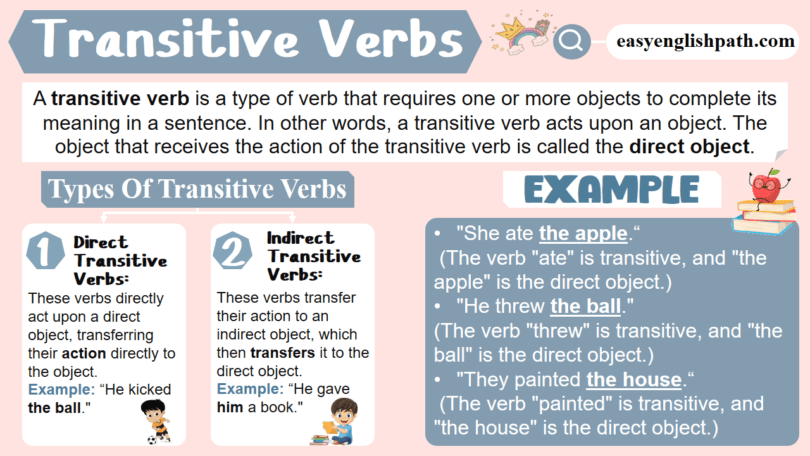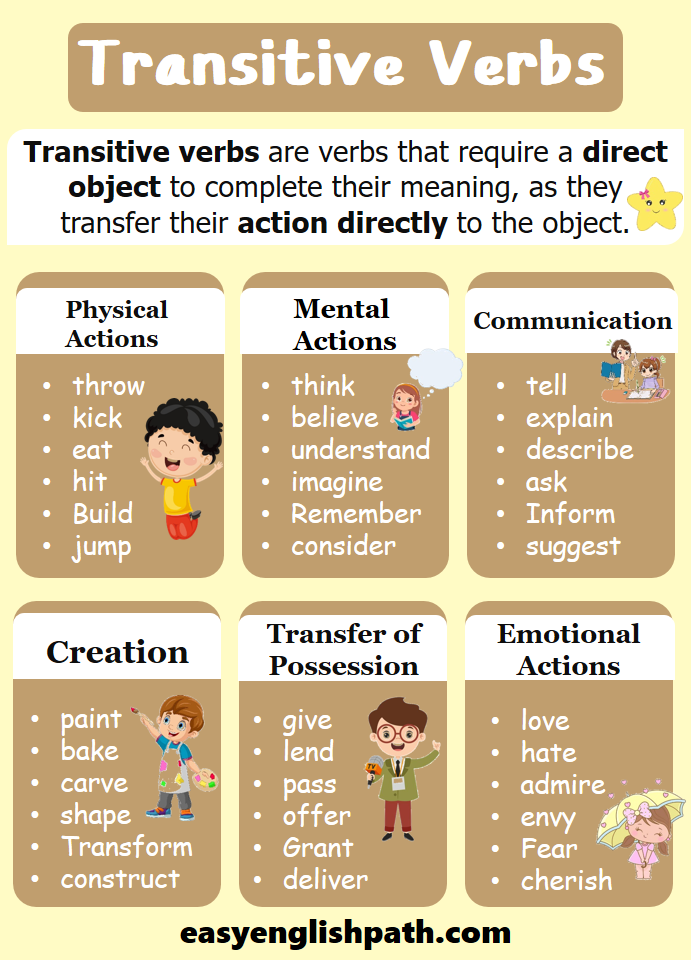Transitive verbs require both a subject (doer of the action) and an object (receiver of the action). They show who does what to whom or what. For example, in John kicked the ball, John (subject) performs the action, and ball (object) receives it. Understanding transitive verbs helps in forming clear, meaningful sentences.
Transitive Verbs:
These are action verbs that require a direct object to complete their meaning in a sentence. In other words, they transfer the action from the subject to the object. The direct object is the noun or pronoun that receives the action of the verb.
- She bought a new dress for the party.
- He built a beautiful house by the lake.
- They cooked dinner for their guests.
Types of Transitive Verbs:
- Simple Transitive Verbs
- Double Transitive Verbs
- Phrasal Transitive Verbs
- Causative Transitive Verbs
- Factitive
1. Simple Transitive Verbs
These verbs have a direct object that directly receives the action of the verb.
- She ate an apple.
- He kicked the ball.
- They wrote a letter.
2. Double Transitive Verbs
These verbs take two objects, a direct object and an indirect object. The direct object receives the action, and the indirect object receives the direct object.
- She gave him a book.
- He showed me his new car.
- They sent her a gift.
3. Triple Transitive Verbs
These verbs consist of a main verb and one or more particles (prepositions or adverbs). They function as a single unit, often with idiomatic meanings.
- He put off the meeting.
- She turned down the offer.
- They looked into the matter.
4. Causative Transitive Verbs
These verbs express causing someone to do something or causing something to happen. They can be followed by both a direct object and an infinitive or a that-clause.
- He made her cry.
- She had her hair cut.
- They got him to sign the contract.
5. Fricative Transitive Verbs
These verbs involve a change of state or condition of the direct object. They often link the direct object with its new state or condition.
- They elected him president.
- She painted the wall red.
- He appointed her manager.
Difference Between Transitive and Intransitive Verbs
| Feature | Transitive Verbs | Intransitive Verbs |
|---|---|---|
| Definition | Require a direct object to complete their meaning. | Do not require a direct object. |
| Function | Transfer action to something or someone. | Express action without affecting an object. |
| Object Needed? | Yes, must have a direct object. | No, the verb stands alone. |
| Example Sentences | She buys a book. (book = direct object) | She sleeps peacefully. (No object) |
| Questions They Answer | What? or Whom? (He wrote a letter. – What did he write?) | How? Where? or When? (He runs fast. – How does he run?) |
Rules for Transitive Verbs
Transitive verbs require a direct object to complete their meaning. They transfer action from the subject to an object.
1. Must Have a Direct Object
A transitive verb cannot stand alone; it needs an object to complete its meaning.
✔ She writes a letter. (letter = direct object)
❌ She writes. (Incomplete)
2. Answers “What?” or “Whom?”
Transitive verbs always answer what or whom after the verb.
✔ He gave me a gift. (What did he give? → A gift.)
✔ She helped her friend. (Whom did she help? → Her friend.)
3. Can Be Used in Passive Voice
Since transitive verbs have an object, they can be used in the passive voice.
✔ She wrote a book. → A book was written by her.
4. Some Verbs Can Be Both Transitive and Intransitive
Some verbs change meaning depending on whether they have an object.
✔ He runs a business. (Transitive – “business” is the object.)
✔ He runs every morning. (Intransitive – no object.)
5. May Have Indirect and Direct Objects
A transitive verb can take both direct and indirect objects.
✔ She gave him (indirect) a gift (direct).
Common List of Transitive Verbs
- Buy
- Bring
- Give
- Make
- Offer
- Show
- Tell
- Send
- Take
- Write
- Love
- Hate
- Want
- Need
- Eat
- Drink
- Read
- Find
- Hold
- Carry
- Sell
- Wear
- Pay
- Call
- Teach
Transitive Verb Examples
- She bought flowers.
- He built a sandcastle.
- They cooked dinner.
- The teacher explained math.
- We cleaned rooms.
- He finished painting.
- She wrote letters.
- They planted seeds.
- He opened a box.
- She sent emails.
Common Mistakes with Transitive Verbs
Transitive verbs require a direct object, and misusing them can lead to incomplete or incorrect sentences.
1. Omitting the Direct Object
Transitive verbs must have an object; without one, the sentence is incomplete.
❌ She bought. (Bought what?)
✔ She bought a new dress.
2. Confusing Transitive and Intransitive Verbs
Some verbs are always intransitive and cannot take an object.
❌ He sleeps a nap. (Incorrect)
✔ He takes a nap. OR He sleeps well.
3. Incorrectly Using Passive Voice
Since transitive verbs can be passive, errors occur when the object is missing.
❌ The book was written. (Who wrote it?)
✔ The book was written by the author.
4. Using the Wrong Object
The object must logically fit the verb’s meaning.
❌ She told a song. (Incorrect)
✔ She sang a song. OR She told a story.
5. Forgetting Indirect Objects in Double-Object Sentences
Some transitive verbs require both a direct and indirect object.
❌ She gave a gift. (To whom?)
✔ She gave her friend a gift.
FAQS on Transitive Verb
1. What is a transitive verb?
A transitive verb is a verb that requires a direct object to complete its meaning. (She bought a car. – “car” is the object.)
2. How do I identify a transitive verb?
Ask “what?” or “whom?” after the verb. If the answer is present, the verb is transitive. (He writes a letter. – Writes what? A letter.)
3. Can a transitive verb have two objects?
Yes, some transitive verbs take both direct and indirect objects. (She gave him (indirect) a book (direct).)
4. Can transitive verbs be used in passive voice?
Yes, because they have an object that can become the subject in passive form. (She wrote a book. → A book was written by her.)
You May Also Like






